Here are the scores and placings from this event; pix and words to follow, all courtesy of Andy Housden!
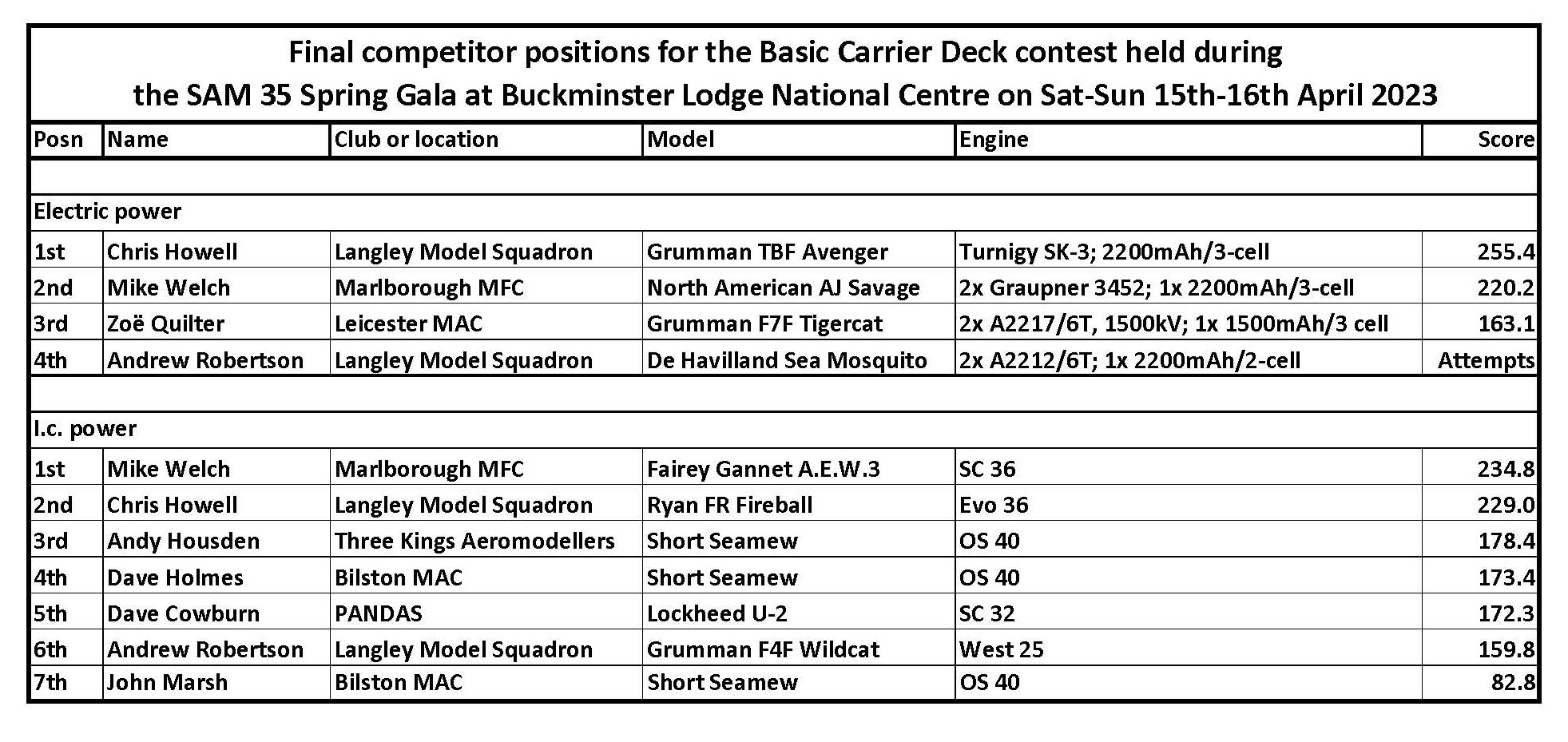
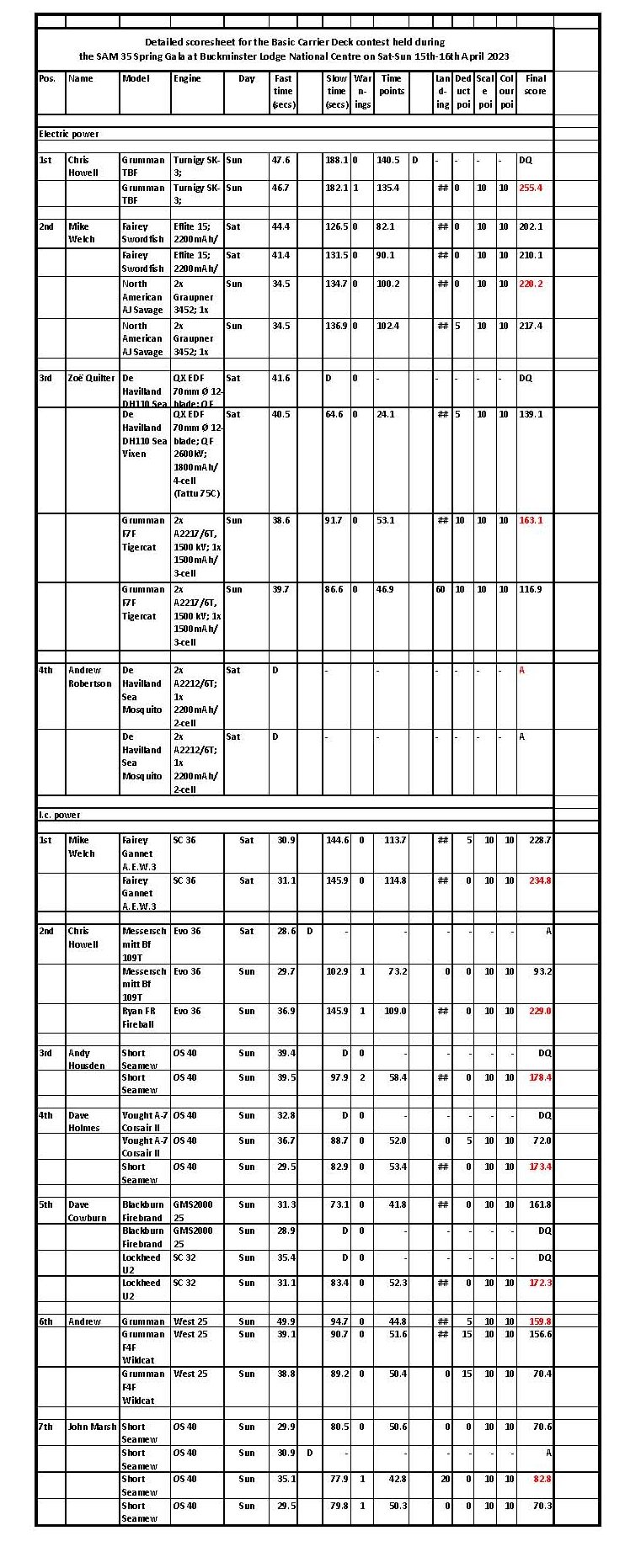
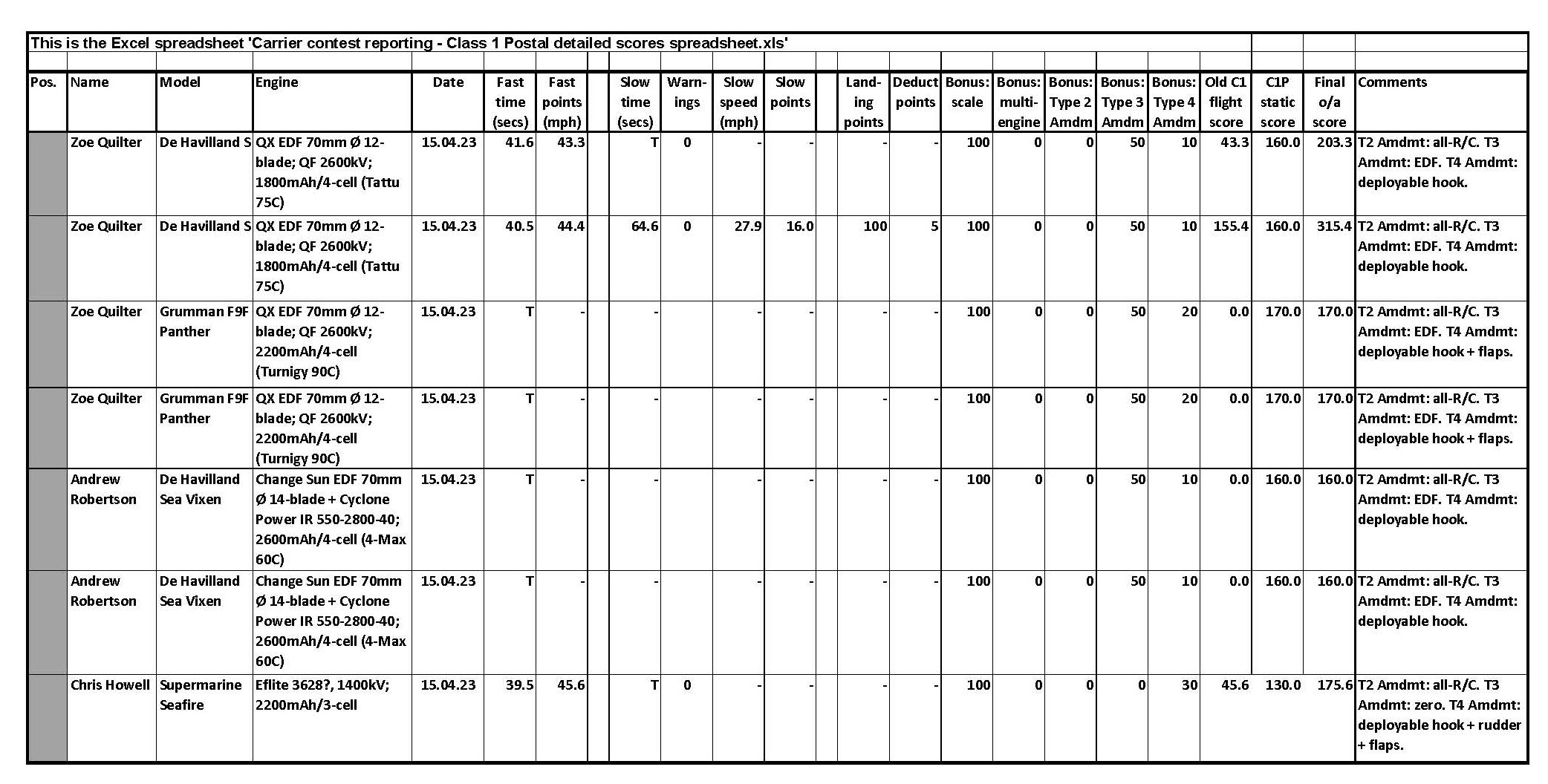
EVENT PIX and REPORT
General photographs

01 Sunday’s line-up in the Pits.

02 A CD’s work is never done – Chris Howell runs the show!
Basic Carrier Deck – electric power model photographs

03 Zoë Quilter flew her Class 1 Electric Ducted Fan DH Sea Vixen in the BCD – electric power sub-class. Perfectly legal, of course, providing a model has no more than the maximum permitted wing area and only the controls allowed by the BCD rules are used. EDF models are invariably more difficult to fly than their propeller-driven equivalents, primarily due to the lack of instant extra prop-induced lift, particularly for deck takeoff and in the ‘downwind hole’ of the flight circle. Also, since almost all EDF models at the moment are ex-R/C foam jets, the insertion of a bellcrank and retaining structure into the middle of a fuselage that is essentially a hollow tube (that must stay clear of obstructions!) not only taxes ingenuity but adds extra weight. Any Carrier model will always have a better performance the lighter it is, and EDF models are particularly susceptible to extra weight. Zoë has spent countless hours of design and redesign of both her Sea Vixen (and her Grumman F9F Panther – see the Class 1 Postal photographs), with the Sea Vixen now at its lightest so far. Both models have the latest technology multiple-blade EDF units, with particular attention paid to the use of LiPo batteries with the highest possible discharge rates compatible with maximum engine power rating. Provided that the battery has enough capacity for a flight, this means that the battery will be the lightest it can be, the model therefore the least inertial mass and the acceleration under maximum thrust the highest value achievable – vital for both takeoff and downwind hole performance. The result is that the Sea Vixen is an absolute treat to watch being flown. It even sounds like the real thing!
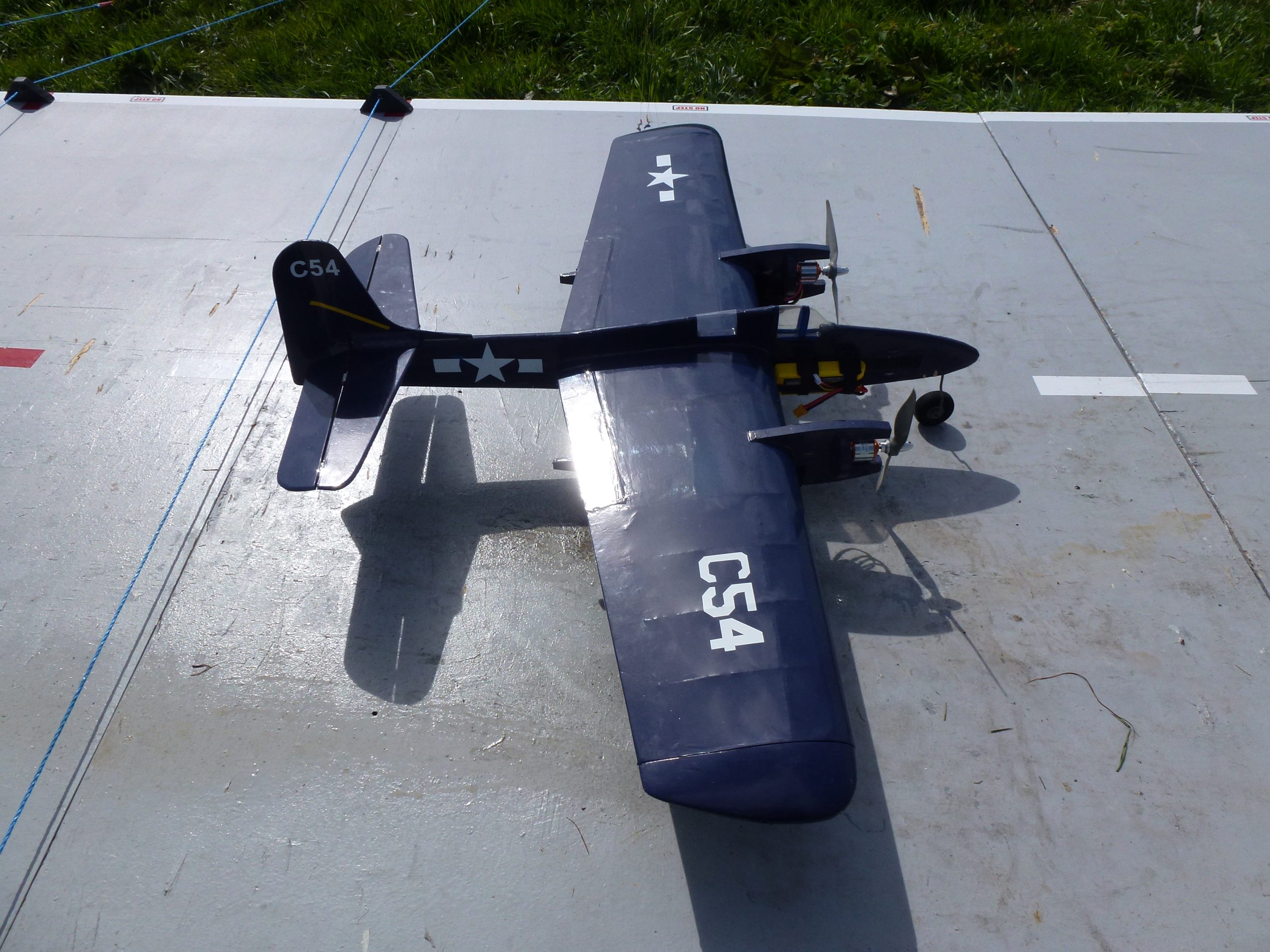
04 I failed to get a photo of Zoe’s BCD – electric power 3rd place flight with her very reliable Grumman F7F Tigercat, so the shot of it shown here is from the same contest but that of a year ago. The weather during that 2022 April weekend was somewhat sunnier as can be seen, but it was also MUCH colder and windier then, with a horribly thick overnight frost. 2023’s weather, by contrast, was much warmer and considerably calmer, even more so than had been forecast!
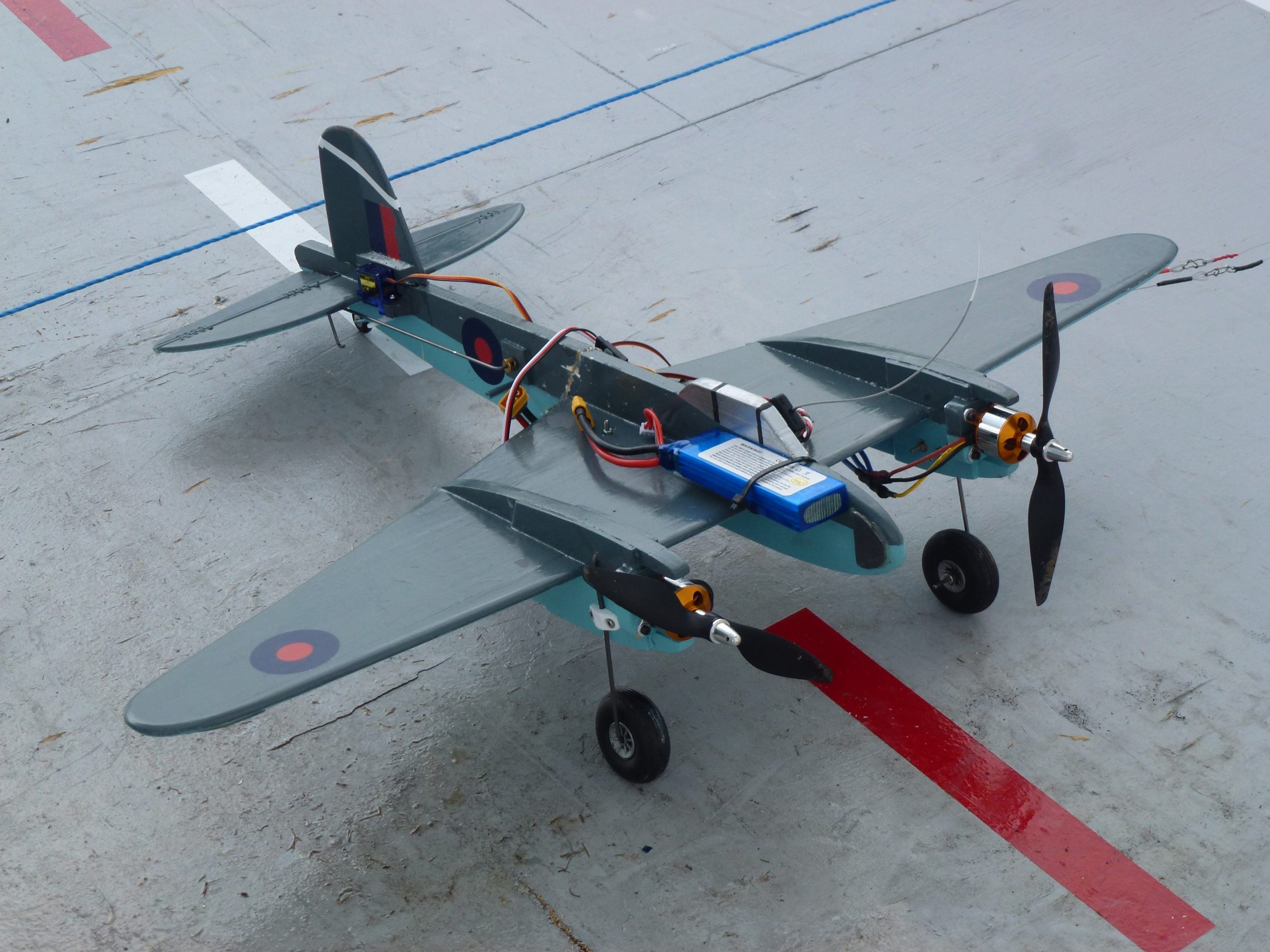
05 Here’s Andrew Robertson’s diminutive JCD model of the DH Sea Mosquito, based upon the classic Frog kit of yore. It was 4th in the BCD – electric power sub-class and had bags of power, getting off the deck with almost no takeoff roll! Unfortunately, air turbulence that would have left a bigger model shaken but not stirred instead threw this weeny beast all over the place and broke it several times! It’s seen here repaired after it’s first encounter with the wind…
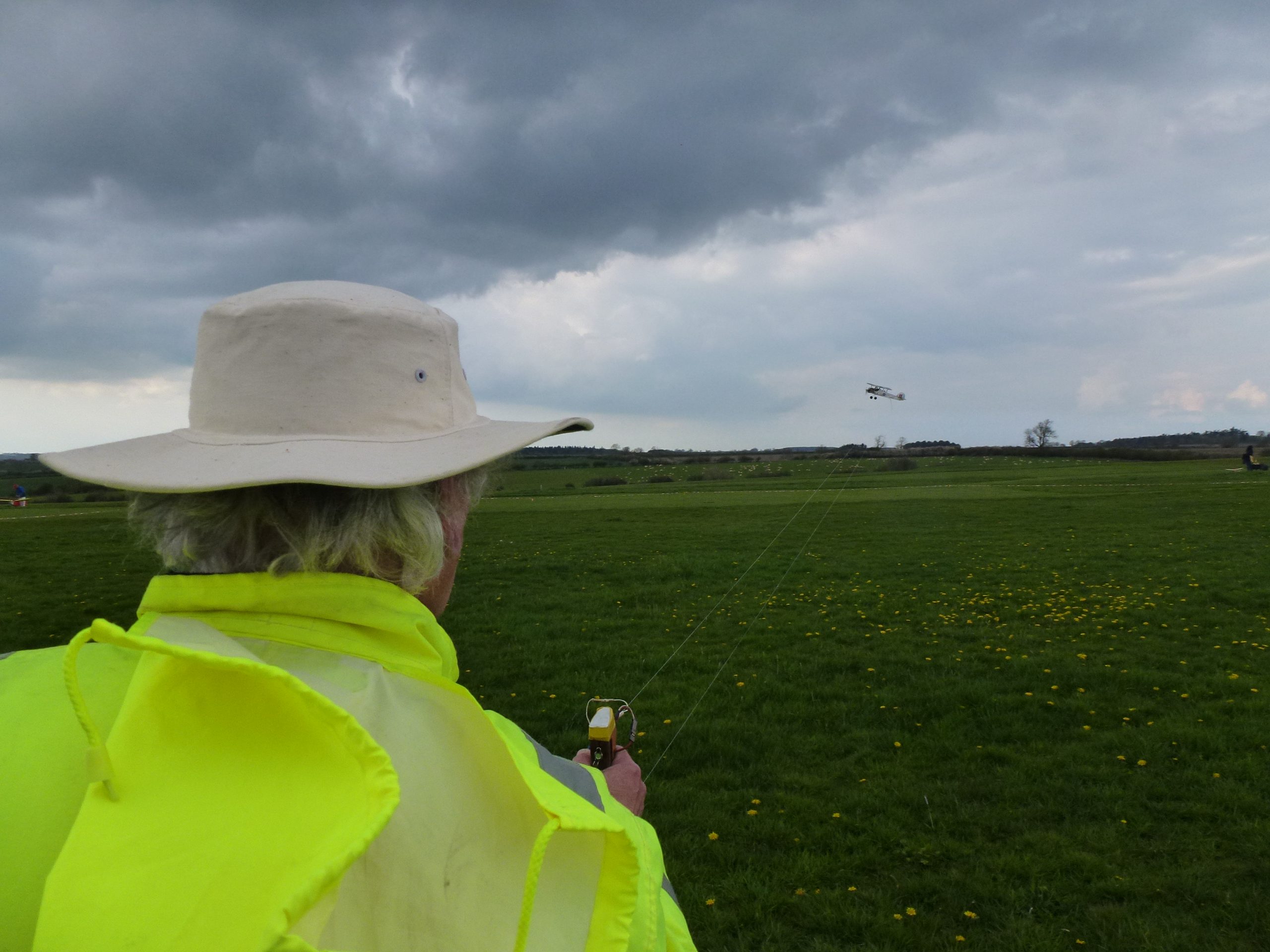
06 Mike Welch flies his electric Fairey Swordfish under Saturday afternoon’s darkening skies. Mike had some trouble finding the right propeller to suit the motor of this model and had better luck with his AJ Savage on Sunday.
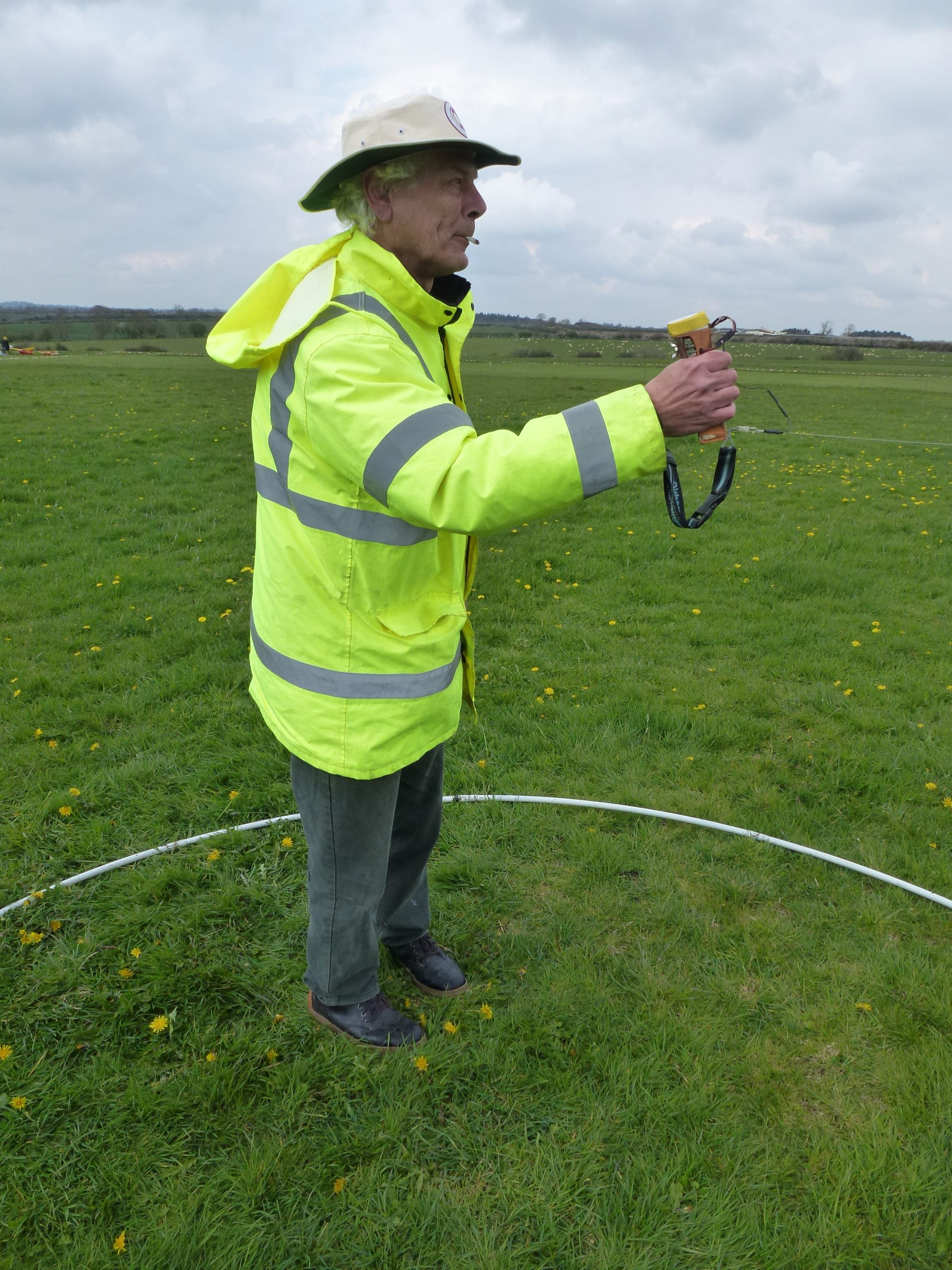
07 Mike Welch and his North American AJ Savage electric twin made 2nd place in the BCD – electric power class. The model is seen here on the second approach at the end of its second Sunday flight after a previous deck-roll-and-overshoot that twanged and therefore slackened off Nos 2 and 3 wires. Fortunately, the hook picked up the still-taught No.4 wire! The Savage has matched engines but unfortunately also has, according to Mike, mismatched Speed Controllers. Despite this, the sound they made during the spool-up process was absolutely fabulous and worthy of a podcast soundbite in its own right. Hmmm… maybe I should get out more often?
In his second flight slow run of his Fairey Gannet A.E.W.3 in the BCD – i.c. class (it’s been re-engined a number of times, necessitating retrimming after each change) the current set-up appears to be the best so far. Although the Gannet needs a breeze into which it can be ‘kited’ to give of its best during slow flight, enough of the required breeze was present to get Mike 1st place!
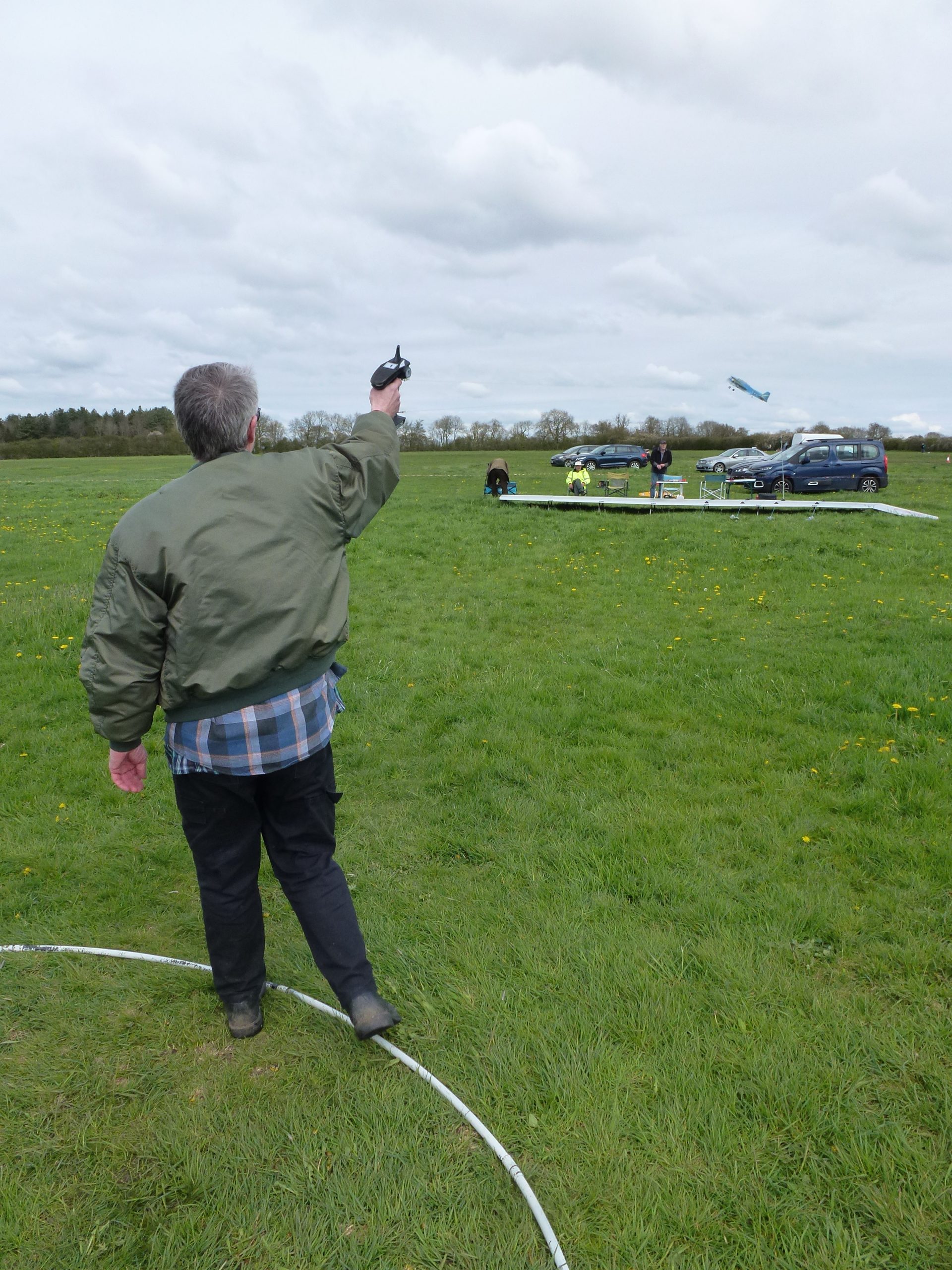
08 Chris Howell shows how to execute slow flying by walking round the very edge of the pilot’s circle and stretching his arm out as well! Chris flew his usual Grumman TBF Avenger in BCD – electric power and whilst had a problem in finding a battery of sufficient reliability – those slow runs of his really do eat up the electricity – once he’d found a good ‘un, 1st place was in the bag
Basic Carrier Deck – I/C model photographs

10 Second place in BCD – i.c. was Chris Howell, though not with his Messerschmitt Bf 109T shown here! This model is a modified Brodak Magician – the original being a stunter, of course – but a practice loop in the airspace above the deck terminated abruptly when the lower part of the flight path was found to be slightly below deck level! Hopefully Chris can put the bits together again as the model made a very realistic 109T indeed.

11 After he had to declare his 109T hors de combat, Chris Howell put the lines onto his trusty Ryan Fireball and, on the very last Carrier flight of the weekend (the takeoff of which is seen here), came a very close 2nd place to Mike Welch’s Saturday top score, missing it only by 5.8 points. The Fireball is now also more pleasant for the CD to watch whilst waiting for its takoff! How so, you are (of course) asking? The Fireball’s profile pilot’s head had broken off some time ago and thereafter rattled around inside the transparent cockpit in time with the engine revs! Chris has now removed said head – and at the same time stopped the CD’s eyeballs involuntarily rotating as well!

12 4th place in BCD – i.c. went to Bilston’s Dave Holmes. Achieving a reliable hookup with his Vought Corsair II in two previous flights appeared somewhat problematic, so he changed to his more capable – and even faster – Short Seamew, for his last flight. No landing, of course, is ever entirely predictable, and the Seamew unluckily plucked at, and missed, the first three wires – but fortunately got hold of No.4 in time to stop (just!) before the end of the deck, as seen here!

13 Andrew Robertson wasn’t feeling 100 percent, but being a trooper, came out to play with his Grumman Wildcat in BCD – i.c. and was (hopefully!) rewarded by two arrested landings out of three flights, plus 5th place. As is often the case when a pilot is putting everything into his (or her) flying, the first flight can often be the best, and it was thus with Andrew, shown here with his Wildcat still airborne after picking up the No.1 wire.

14 Dave Cowburn flies at relatively high speeds, but due to his aerobatics expertise can achieve remarkably accurate landings. He was fortunately able to do all this during his Blackburn Firebrand’s first flight as it subsequently turned out to have a loose carburettor, the fault finally resulting in a ditch during the model’s second flight. Despite a change to his higher performance Lockheed U-2, the first of this latter model’s two flights also suffered from a slow run ditch due to a different engine-related problem. Only after curing this was Dave able to make a fourth and last flight that ended with a good example of a fast, low, precision landing directly onto the No.1 wire which gave him 6th place in BCD – i.c. Dave is seen here during this latter flight’s slow run, looking suitably composed now that his U-2’s engine was running properly again!

15 Seen here with his characteristic ‘horizontal handle’ slow flight technique, our Carrier CAD-man and Librarian (and Archivist! Are there any better and more dynamic names available for this vital function?) John Marsh chose to use Bilston clubmate Dave Holmes’ Short Seamew instead of his usual Fairey Gannet A.E.W.3 for BCD – i.c., due to the latter’s electronic throttle problems. Perhaps because of his relative unfamiliarity with this model – though more possibly the fact that it was someone else’s model with which he was reluctant to take too many risks – John pulled his punches somewhat during the landings, with the result that none were hookups and his final placing in the weekend’s proceedings was 7th.
Class 1 Postal model photographs

16 Zoë Quilter’s EDF-powered De Havilland Sea Vixen, already described in the BCD – electric power section, is shown making a takeoff from HMS Incontinent during a sunny period on the Saturday. Zoë has lightened this converted R/C model as much as possible, and that includes substituting a fixed U/C for the original retracting units. For Class 1 Postal (C1P) scoring, the Sea Vixen picks up a number of points additional to those provided under the existing Class 1 rules: EDF power gets an extra 50 points from the ‘Type 3 Amendments’ (model diversity) category, and although her removal of the retracts loses her 10 bonus points from the ‘Type 4 Amendment’ (working control systems) category, the flight performance improvement due to the weight reduction is more than worth the loss.

17 A very pleased Zoë Quilter after her second Sea Vixen C1P flight which finished with a full score landing and hookup on the No.4 wire. So, with the airframe setup now fully flight-proven, Zoë will continue to experiment with the power system for even better flight performance.

18 Andrew Robertson’s DH Sea Vixen accelerates along HMS Incontinent for its 2nd attempt – but also to a 2nd watery fate off the bows! Andrew’s Sea Vixen is the same model as that of Zoë Quilter but heavier and with a slightly different power train, with the result that thrust is not quite enough to obtain adequate flying speed. As Carrier’s EDF jets are very much in the experimental stage, obtaining enough power to get a model airborne in the limited distance of a standard carrier deck is still problematic for everyone – so Andrew has further work ahead of him!
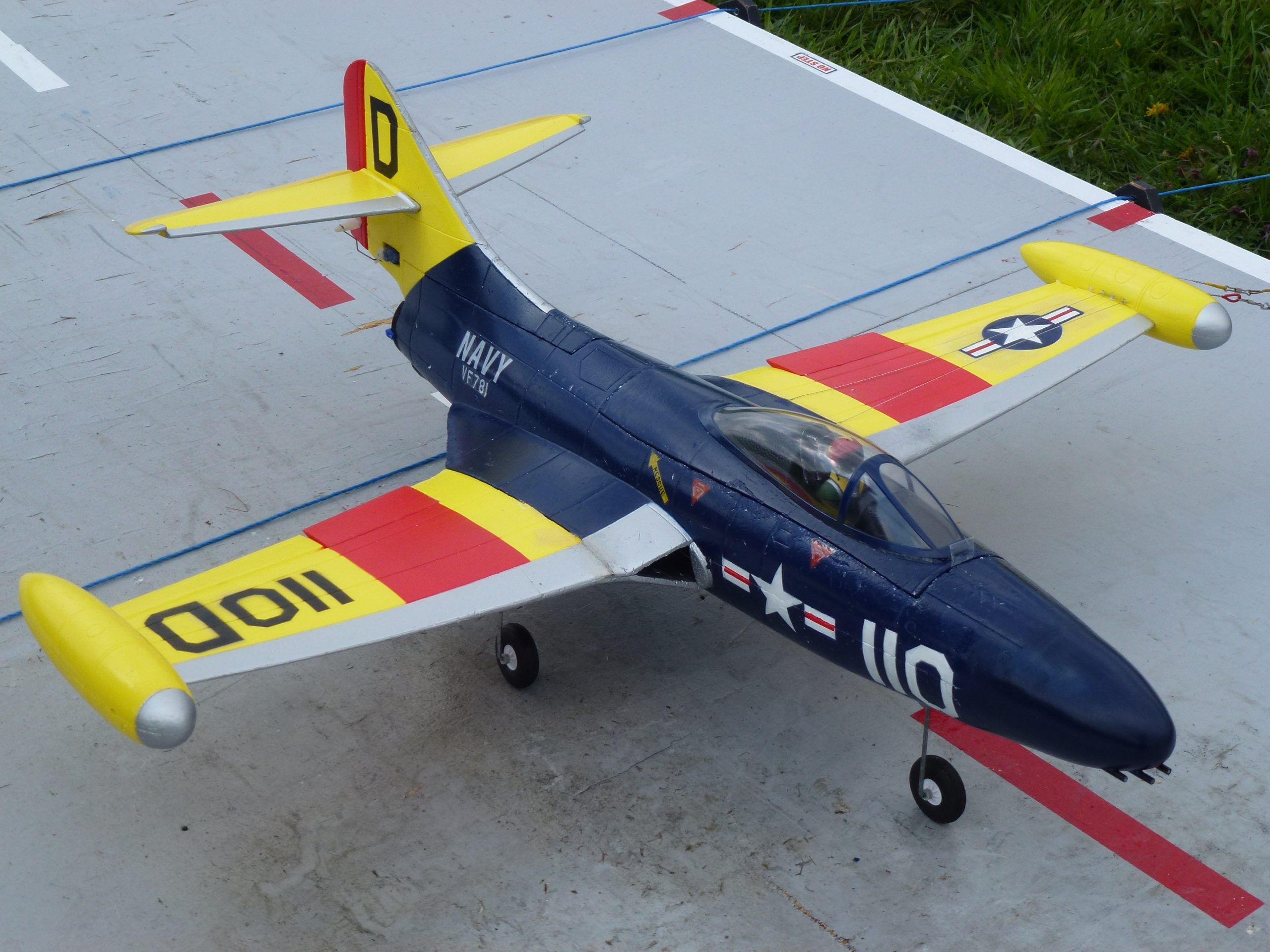
19 Zoë Quilter’s extremely smart Grumman F9F Panther, another very pleasing example of a converted R/C EDF-powered foam model. Unlike her Sea Vixen which has a considerably greater amount of wing area – and therefore a lower wing loading and therefore, of course, a lower takeoff speed – the Panther currently struggles to get airborne in the available deck length. More power may appear to be the obvious solution, but beware! If additional thrust is to come in the form of simply a more powerful but heavier battery, the extra mass will certainly increase wing loading (undesirable!) and perhaps even negate the increase in takeoff acceleration otherwise provided by the extra thrust! The problem of adequate EDF power is not a straightforward matter! In addition to the efflux vane seen in the next photograph, Zoë is considering a new and more powerful fan unit/motor combination (but which, unfortunately, will require some internal fuselage enlargement), and is also making up her own non-standard battery to provide greater motor voltage but with the minimum possible extra weight. It’s worth saying here that, although the technical details of EDF-power are obviously dissimilar to those of full-size jet turbines, we are having exactly the same problems of finding enough ‘ooomph’ to operate our models off our own decks as did the full-size early post-war jets from their full-size carriers! Part of the latter’s solutions were the British invention of the steam catapult, of course – and we might be able to replicate that in due course with bungee ‘technology’. Work in progress!

20 Here’s a view of the EDF efflux vane Zoe Quilter has designed, 3D-printed herself and installed on her Grumman F9F Panther. Directly connected to and working in concert with elevator movement, the vane, whilst deliberately quite small, provides a sufficient amount of efflux deflection to change model attitude. As airspeed on takeoff is currently marginal for both lift and pitch control for the Panther, the vane is hoped to add enough pitch authority to keep the model at a steep enough attitude for adequate lift while pilot waits for the model to accelerate to a sensible airspeed. Yes, it’s all more experimentation! Although the vane was absent in the full-size aircraft, it is certainly acceptable for use in C1P while we develop the Carrier EDF genre.

21 Here’s a very handsome Supermarine Seafire – but of the US Pacific Fleet! Converted by Chris Howell from an R/C electric foam model, it flies very well and, if not for a slow run ditch during its maiden contest flight that damaged the undercarriage, could certainly have achieved a very reasonable full score. The model has working rudder and flaps as well as a deployable hook, and will have ailerons and retracts when Chris adds these to the R/C Tx. All good stuff, particularly as each of these ‘Type 4 Amendment’ control functions are worth 10 points per item in C1P!
